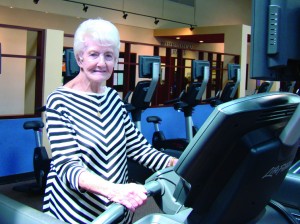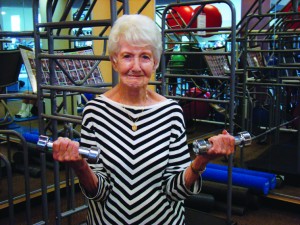by Michelle Sutton-Kerchner
The reasons are countless. Here are some of the best. If these don’t get you off the couch and moving, not much will …
“If You Don’t Exercise, You Get Stiff.”
So says wise member Lillian Briggs. At 94 years young, she would know. Lillian visits the Center three times a week where she tackles everything from weightlifting to cardio fitness. This feat alone is motivation enough to get us on the Exercise Floor. Exercising since she was 20 years old, including as a dancer and dance instructor at the famed Arthur Murray Dance Schools, Lillian is exemplary. She represents the benefits of living a healthy, active life.
Imagine what can be accomplished when the average 34-year-old commits to fitness.

Clearly, exercise increases longevity. Studies prove this, as does a look around the Center.

A proper exercise regimen includes a warm-up and stretching. Think these are just formalities? Think again:
- Enjoy better balance.
- Increase the blood flow to your muscles.
- Feel yourself come alive to accomplish the best workout possible. Oxygen is delivered to your muscles at a higher rate; waste products like carbon dioxide and lactic acid are carried away.
- Warm, stretched muscles help prevent injury.
Combined with the heart of a fitness program, your body stays limber. Flexibility allows freedom of movement and leaves one predisposed to lifelong independence.
Maintain a Healthy Weight
 Exercise can help almost any health condition. Yet, losing weight is probably the most common fitness goal. People want to burn calories. The most effective and efficient method is through an invigorating aerobic workout.
Exercise can help almost any health condition. Yet, losing weight is probably the most common fitness goal. People want to burn calories. The most effective and efficient method is through an invigorating aerobic workout.
Fad diets help lose initial pounds, especially when combined with a fitness routine. However, it takes a commitment to a healthy lifestyle– both nutritious eating, which is not necessarily the same as dieting, and regular exercise. Without these two elements, the pounds creep back. Ask any who have lost an impressive amount of weight. Taking off the pounds is easy compared to keeping them off. For that, you need to make exercise a habit.
Combat Health Issues
From helping cancer survivors to lowering blood pressure and cholesterol, exercise works. Some of the country’s biggest killers can be can be averted, including heart disease, type 2 diabetes, stroke, and various cancers. A fit heart beats more slowly and efficiently, which benefits the entire body through better blood flow. Increased oxygen to all tissues and the lungs keeps the cardiovascular system in healthy condition. A muscular body burns fat even at rest, making obesity and its related health issues less likely.

Doing something healthy for yourself as you face health challenges can create its own healing power. For some, it’s an element of normalcy to which they can cling. It provides an escape, a chance to alleviate worries and go beyond traditional medicine. It’s an opportunity to do something enjoyable.
A safe, invigorating workout encourages a positive outlook and improves self-confidence. During any health crisis, it’s essential to believe in yourself and your body’s capabilities. Exercise accomplishments can reflect your outer and inner strength– and sometimes improve your condition.
Boost Immunity
In addition to chronic health problems, exercise is preventative medicine for everyday viruses. Common colds and flu are often avoided by those who practice a regular fitness routine. Those who are physically active on a daily basis are 20 to 30 percent less likely to suffer colds than their inactive counterparts. The next time you think you don’t have time for a workout, ask yourself if you have time for illness.
Approximately seven of every 100 people suffer from depression at some point in their lives after age 18 years. Information gathered from countless studies reports exercise provides an immediate boost as well as long-term relief for those suffering from depression and anxiety, similar to that offered by medication and talk therapy. Fire up those brain chemicals (Go, endorphins!) and increase circulation. Your brain will feel relaxed, refreshed, and content.
Many physicians are beginning to recommend exercise as the first line of defense against depression and anxiety disorders. Mild to moderate depression often responds as well to exercise as it would to medication. Unlike the potential negative side-effects of drugs, exercise provides positive “side-effects” like increased self-confidence and perhaps a new support group in the form of fitness friends.
In short-term studies, researchers find people show equal compliance to an exercise regimen as they do medication. The immediate boost helps long-term adherence to exercise unlike a trial period with drugs, which can be disheartening and frustrating during the adjustment period.
Improved mood, increased energy, and decreased stress contribute to exercise’s other benefits, including the ability to ward off viruses and enjoy a better night’s sleep.
Energize
An energy deficit seems unnecessary in a world where coffee shops are almost at every corner and energy drinks can be purchased in monster doses at check-out lines. Two words: post-caffeine crash.
Steady exercise increases stamina and helps reduce fatigue. Although you may feel winded after a go on the rowing machine, energy generated through regular exercise increases slowly and steadily. The more you do, the more immediate– and lasting– the benefits. Once exercise becomes a frequent activity, you’ll find yourself scheduling it on days you have much to accomplish. The extra surge of energy will more than compensate for the time it takes to fit in a workout.
Sleep Better
 This may seem to contradict that generated surge of energy, yet because of it we are better able to sleep. Exercise produces healthy physical stress. The brain responds to this healthy exhaustion by increasing time spent in the deepest stage of sleep.
This may seem to contradict that generated surge of energy, yet because of it we are better able to sleep. Exercise produces healthy physical stress. The brain responds to this healthy exhaustion by increasing time spent in the deepest stage of sleep.
Aerobic exercises, which increase the amount of oxygen in the bloodstream, are best for combating restless nights. Cycle, dance, Zumba, swim, hit the treadmill. Pump up the cardio. Any physical activity that reaches a level of exertion is helpful. Spent energy and released tension are the ideal sleep aide.
You can’t always guarantee the optimum hours of sleep; however, a replenishing sleep can be possible during the hours you do manage. Research proves moderate exercise for at least half-hour, seven days per week, has the best outcome for a good night’s rest.
Age Well
Sure, exercise helps you accomplish a youthful glow that radiates a younger appearance. But, there’s more than meets the eye. It also helps older adults live healthy, active lives with a sharp mind. Exercise helps maintain strong muscles and bones, strengthens the body’s core, and improves balance. This is critical for mobility in later years when falls are more dangerous, and rising from a chair can be a challenge.
The Framingham Heart Study, which followed 5,000 residents of Framingham, Massachusetts over four decades, found people who exercised vigorously for 30 minutes five days per week lived almost four years longer than their peers. Simply walking five days per week added 1.3 to 1.5 years to their lifespan. Additionally, their later years were spent in good health.
Dementia, including Alzheimer’s disease, is less prominent in those who live physically active lives. Energizing the brain through exercise plays a role in Alzheimer’s prevention. Studies suggest daily physical exercise — in all age groups– may reduce the risk of Alzheimer’s and cognitive decline.
Exercise keeps the brain itself sharp through chemical reactions in the brain, as well as reduces secondary factors that may contribute to cognitive decline. Experts suggest at least 30 minutes of aerobic exercise three days a week to reduce cognitive decline in older adults.

Lillian can attest to these facts while she pumps iron on the Exercise Floor. Her advice, “Keep exercising and don’t ever give up.” Her other secrets include eating three meals a day and avoiding sweets.
With a healthy body and mind, life is already plenty sweet.
Sources
Aerobic Exercise: Top 10 Reasons to Get Physical,” at www.mayoclinic.com.
Image Credits
Smiling young woman (introductory photo): http://www.flickr.com/photos/evoo73/5868828498/
Tape measure: www.flickr.com/photos/24975064@N05/3986897858/in/photostream/
Flower of hope: http://www.flickr.com/photos/maf04/6237594773/
Peaceful sleep: http://www.flickr.com/photos/mikecpeck/2104496895/
 Fitness & Wellness News Your Source for Fitness News, Wellness News, Health News, and Nutrition News!
Fitness & Wellness News Your Source for Fitness News, Wellness News, Health News, and Nutrition News!



